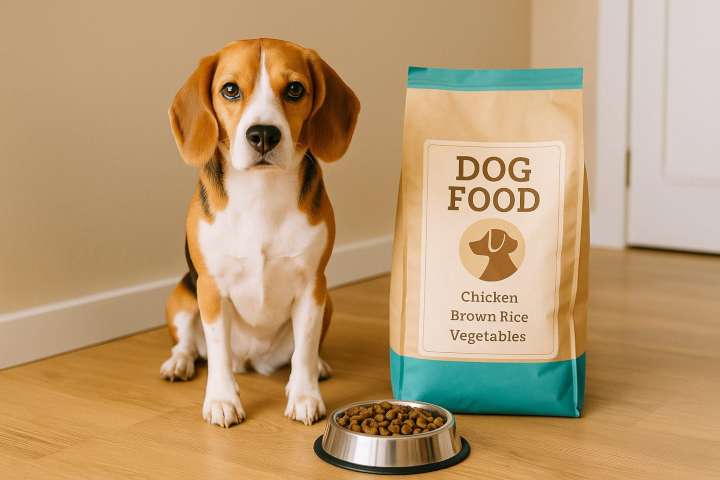How to read dog food labels is a skill every pet owner should master to make informed decisions. Picking the right dog food isn’t just about flashy packaging or trendy buzzwords—it’s about understanding the label. Hidden behind the fine print are the real clues to your dog’s nutrition: ingredients, nutrient levels, sourcing, and even marketing tricks.
In this guide, you’ll learn how to decode dog food labels like a professional, so you can choose the healthiest option for your dog with confidence—every time.
1. Check for the AAFCO Statement
Look for a sentence that says the food is:
“Formulated to meet the nutritional levels established by the AAFCO Dog Food Nutrient Profiles.”
This means the food is complete and balanced for a specific life stage (puppy, adult, senior, all life stages). Avoid foods that say «intended for intermittent or supplemental feeding» unless prescribed by your vet.
Ingredients are listed by weight before cooking, meaning the first few ingredients are the most important.
- Real meat as the first ingredient (e.g., chicken, beef, salmon)
- Named meat meals (e.g., chicken meal, lamb meal—not «meat meal»)
- Whole grains (brown rice, oats, barley) if not grain-free
- Healthy veggies and fruits for vitamins and antioxidants
🚫 What to avoid:
- “Meat by-product” or “animal digest” (low-quality, undefined sources)
- Artificial colors, flavors, or preservatives (e.g., BHA, BHT, ethoxyquin)
- Sugar, syrups, or excessive salt
- Ingredient splitting (e.g., rice, rice flour, brewers rice) to disguise fillers
3. Analyze the Guaranteed Analysis
Nutrient | What It Means |
|---|---|
Crude Protein | Essential for muscles, immune system |
Crude Fat | Energy, coat health, brain development (esp. for puppies) |
Crude Fiber | Digestive health—too much can mean poor digestibility |
Moisture | Important in canned foods, not usually relevant in kibble |
Tip: Compare on a dry matter basis if you’re comparing kibble to wet food.
4. Look at the Life Stage & Feeding Purpose
Make sure the label states whether it’s for:
- Puppies (growth)
- Adults (maintenance)
- Seniors
- All life stages (good for multi-dog households)
- Large breed puppies (requires controlled calcium levels)
Foods should match your dog’s age, size, and activity level.
5. Understand Feeding Guidelines
Feeding charts are usually found on the back or side of the bag. These are general starting points—you may need to adjust based on:
- Your dog’s age, weight, and energy level
- Whether your dog is spayed/neutered
- Weight management goals
Tip: Always measure your dog’s food with a scale or measuring cup to avoid overfeeding.
6. Learn to Spot Marketing Tricks
Just because a label says:
- “Premium”
- “Holistic”
- “Natural”
- “Human grade”
…doesn’t mean it’s better. These terms are often not regulated, and may be used to increase price without improving quality.
Instead, rely on:
- Ingredient quality
- Transparency
- Vet recommendations
- AAFCO compliance
7. Identify Country of Origin and Manufacturer
Choose brands that:
- Clearly state where the food is made
- Use locally sourced ingredients when possible
- Are transparent about who manufactures their food (some brands outsource to low-quality facilities)
Made in the USA, Canada, Europe, or New Zealand is typically a good sign—but always look deeper than the label.
8. Look for Bonus Features (If Needed)
Some premium foods include extras like:
- Probiotics for digestion
- Glucosamine/Chondroitin for joint support
- Omega-3s (EPA/DHA) for coat and brain health
- Low glycemic carbs (sweet potatoes, lentils)
Just remember: these should support the core formula, not distract from poor ingredient quality.
Conclusion
Final Thoughts on How to Read Dog Food Labels
Dog food labels can be confusing—but once you know what to look for, you’ll be able to separate the truly healthy options from the clever marketing.
By reading the ingredient list, understanding the guaranteed analysis, and matching the formula to your dog’s life stage and needs, you’ll be better equipped to feed for health, not hype.
Want a printable dog food label checklist or comparison chart? Visit our Dog Nutrition Toolkit for easy guides and expert tips.

